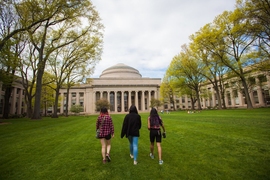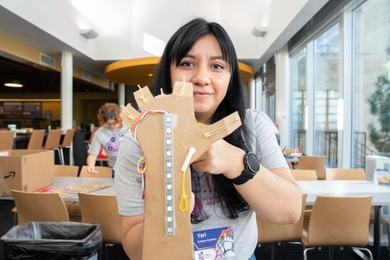Undergraduates with family income below $200,000 can expect to attend MIT tuition-free starting next fall, thanks to newly expanded financial aid. Eighty percent of American households meet this income threshold.
And for the 50 percent of American families with income below $100,000, parents can expect to pay nothing at all toward the full cost of their students’ MIT education, which includes tuition as well as housing, dining, fees, and an allowance for books and personal expenses.
This $100,000 threshold is up from $75,000 this year, while next year’s $200,000 threshold for tuition-free attendance will increase from its current level of $140,000.
These new steps to enhance MIT’s affordability for students and families are the latest in a long history of efforts by the Institute to free up more resources to make an MIT education as affordable and accessible as possible. Toward that end, MIT has earmarked $167.3 million in need-based financial aid this year for undergraduate students — up some 70 percent from a decade ago.
“MIT’s distinctive model of education — intense, demanding, and rooted in science and engineering — has profound practical value to our students and to society,” MIT President Sally Kornbluth says. “As the Wall Street Journal recently reported, MIT is better at improving the financial futures of its graduates than any other U.S. college, and the Institute also ranks number one in the world for the employability of its graduates.”
“The cost of college is a real concern for families across the board,” Kornbluth adds, “and we’re determined to make this transformative educational experience available to the most talented students, whatever their financial circumstances. So, to every student out there who dreams of coming to MIT: Don’t let concerns about cost stand in your way.”
MIT is one of only nine colleges in the US that does not consider applicants’ ability to pay as part of its admissions process and that meets the full demonstrated financial need for all undergraduates. MIT does not expect students on aid to take loans, and, unlike many other institutions, MIT does not provide an admissions advantage to the children of alumni or donors. Indeed, 18 percent of current MIT undergraduates are first-generation college students.
“We believe MIT should be the preeminent destination for the most talented students in the country interested in an education centered on science and technology, and accessible to the best students regardless of their financial circumstances,” says Stu Schmill, MIT’s dean of admissions and student financial services.
“With the need-based financial aid we provide today, our education is much more affordable now than at any point in the past,” adds Schmill, who graduated from MIT in 1986, “even though the ‘sticker price’ of MIT is higher now than it was when I was an undergraduate.”
Last year, the median annual cost paid by an MIT undergraduate receiving financial aid was $12,938, allowing 87 percent of students in the Class of 2024 to graduate debt-free. Those who did borrow graduated with median debt of $14,844. At the same time, graduates benefit from the lifelong value of an MIT degree, with an average starting salary of $126,438 for graduates entering industry, according to MIT’s most recent survey of its graduating students.
MIT’s endowment — made up of generous gifts made by individual alumni and friends — allows the Institute to provide this level of financial aid, both now and into the future.
“Today’s announcement is a powerful expression of how much our graduates value their MIT experience,” Kornbluth says, “because our ability to provide financial aid of this scope depends on decades of individual donations to our endowment, from generations of MIT alumni and other friends. In effect, our endowment is an inter-generational gift from past MIT students to the students of today and tomorrow.”
What MIT families can expect in 2025
As noted earlier: Starting next fall, for families with income below $100,000, with typical assets, parents can expect to pay nothing for the full cost of attendance, which includes tuition, housing, dining, fees, and allowances for books and personal expenses.
For families with income from $100,000 to $200,000, with typical assets, parents can expect to pay on a sliding scale from $0 up to a maximum of around $23,970, which is this year’s total cost for MIT housing, dining, fees, and allowances for books and personal expenses.
Put another way, next year all MIT families with income below $200,000 can expect to contribute well below $27,146, which is the annual average cost for in-state students to attend and live on campus at public universities in the US, according to the Education Data Initiative. And even among families with income above $200,000, many still receive need-based financial aid from MIT, based on their unique financial circumstances. Families can use MIT’s online calculators to estimate the cost of attendance for their specific family.
This past summer, MIT’s faculty-led Committee on Undergraduate Admissions and Financial Aid was publicly charged by President Kornbluth with undertaking a review of the Institute’s admissions and financial aid policies, to ensure that MIT remains as fully accessible as possible to all students, regardless of their financial circumstances. The steps announced today are the first of these recommendations to be reviewed and adopted.








